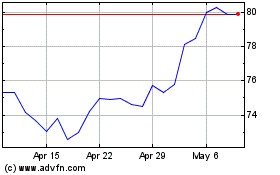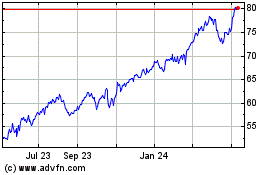AIG Directors to Discuss Whether to Penalize or Oust CEO Over Fourth-Quarter Results -- Update
February 27 2017 - 2:00PM
Dow Jones News
By Joann S. Lublin, Leslie Scism and David Benoit
Directors of American International Group Inc. are trying to
determine whether to blame -- and possibly replace -- Chief
Executive Peter Hancock following a major setback in the insurance
giant's turnaround plan, people familiar with the matter said.
Mr. Hancock's 15 fellow directors are expected to debate at an
early March board meeting various potential actions, including
cutting his bonus or removing him, some people said. Some cautioned
it is premature to predict any particular outcome at this point,
and that the board will look broadly at management's role.
The discussion marks a sign of lessened board support for the
58-year-old Mr. Hancock, who has run the giant insurer for more
than two years. It is fallout from a $3.04 billion fourth-quarter
loss, one of AIG's worst results since the U.S. government bailed
it out during the financial crisis.
The stock fell 9% on the Feb. 14 earnings announcement and
additional bad news the next day: lowered targets for improving two
closely watched profit measures.
Directors want to know "how did this happen, and who, if anyone,
should be held accountable for this?" one person said.
In response to a request for comment from Mr. Hancock and the
board's chairman, Douglas Steenland, AIG said that "AIG's Board of
Directors and management team" are focused on their "clearly
defined transformation plan for the company to deliver high
quality, sustainable earnings."
The statement added, "At this point every year, we actively
review our past and future expected performance against our plan,
and this year is no exception."
Mr. Hancock faces a defined timetable for improving AIG's
profitability. Amid calls in late 2015 by billionaire investors
John Paulson and Carl Icahn for a breakup of the company, he and
the board laid out steps in January 2016 to bridge the company's
big gap in performance with peers. They set a deadline of December
2017. Mr. Icahn also called for Mr. Hancock's firing.
Those pledges were key in the activists' decision to pass on a
board fight last year, and last spring AIG added Mr. Paulson and a
representative of Mr. Icahn to the board.
AIG's board is large, and views are expected to vary, the people
said. Of the 16 board members, Mr. Hancock is the only member of
management, and the others are all classified as independent
directors.
The board in March also may discuss whether one of the directors
would replace Mr. Hancock as interim CEO, one person said. Some
members have insurance-industry experience.
The steep slide in AIG's shares on Feb. 15 represented the
stock's biggest one-day percentage decline since 2011. AIG was the
day's biggest loser in the S&P 500. The stock has regained some
ground, but at Friday's close remained 4.9% below the Feb. 14
closing price.
AIG's fourth-quarter loss was driven by a larger-than-expected
$5.6 billion boost to claims reserves for its core business of
selling property-casualty policies to businesses world-wide. The
company said the charge involved an array of liability policies
such as medical malpractice coverage. Some were issued more than a
decade ago, but a full $3 billion of the boost covers policies from
2011 to 2015. Mr. Hancock, a former bank chief financial and risk
officer, ran the property-casualty unit from 2011 to 2014, before
his promotion to CEO.
The reserve boost followed a $3.6 billion increase for reserves
in 2015's fourth quarter, when some investors thought AIG had
brought them to an appropriate, conservative level.
The huge additional reserve bolstering raises questions "that
AIG simply didn't adequately understand its book of business,"
Keefe, Bruyette & Woods analyst Meyer Shields said.
AIG has said that most of the claims costs reflected in the
fourth-quarter reserve charge will be covered by a reinsurance
agreement that the insurer announced in January with Warren
Buffett's Berkshire Hathaway Inc.
AIG averted a possible bankruptcy brought on by other problems
in 2008 thanks to its nearly $185 billion federal bailout. AIG's
current challenges with money-losing policies appear to stem at
least partly from its comeback attempt after its near collapse.
Then, some rivals complained that AIG was undercutting them on
price as a way to keep customers from fleeing. AIG fully repaid
taxpayers by late 2012, then focused on trying to close its
profitability gap with rivals.
Over the past year, Mr. Hancock's team has sold operations and
assets deemed noncore, cut expenses and exited some problematic
insurance lines while scaling back others, shedding billions of
dollars of liability-insurance business that was unprofitable or
not profitable enough. At the same time, Mr. Hancock has spent
heavily to upgrade the company's information-technology
systems.
AIG also promised investors last year that it would to return
$25 billion to shareholders by this year's end, through
stock-buyback programs and dividends. Between January 2016 through
early this month, it had returned $14.3 billion.
Write to Joann S. Lublin at joann.lublin@wsj.com, Leslie Scism
at leslie.scism@wsj.com and David Benoit at
david.benoit@wsj.com
(END) Dow Jones Newswires
February 27, 2017 13:45 ET (18:45 GMT)
Copyright (c) 2017 Dow Jones & Company, Inc.
American (NYSE:AIG)
Historical Stock Chart
From Mar 2024 to Apr 2024

American (NYSE:AIG)
Historical Stock Chart
From Apr 2023 to Apr 2024
